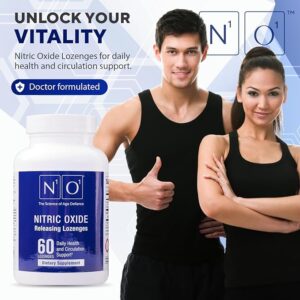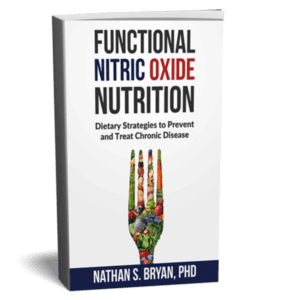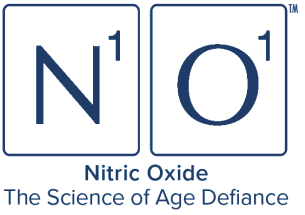Understanding the Impact of Nitric Oxide on Blood Pressure: A Comprehensive Guide

By Nathan S. Bryan, Ph.D.
09/11/2024
Nitric oxide (NO) is a gas molecule that plays a crucial role in the regulation of blood pressure and vascular health. NO is produced by the endothelium, which is the inner lining of blood vessels, and is responsible for vasodilation, or the widening of blood vessels. This results in increased blood flow and decreased blood pressure. Because of its importance for cardiovascular health, NO has been the subject of extensive research, and understanding its impact on blood pressure is crucial for the development of effective therapeutic interventions.
The role of NO in the regulation of blood pressure is complex and multifaceted. NO acts on multiple pathways involved in blood pressure regulation, including the renin-angiotensin-aldosterone system, sympathetic nervous system, and endothelin-1. Factors such as age, gender, and lifestyle can affect NO levels and contribute to the development of hypertension. Understanding the factors that affect NO levels and the mechanisms by which NO regulates blood pressure is essential for the development of effective treatments for hypertension.
Key Takeaways
- Nitric oxide is a gas molecule produced by the endothelium that plays a crucial role in the regulation of blood pressure and vascular health.
- NO acts on multiple pathways involved in blood pressure regulation, and factors such as age, gender, and lifestyle can affect NO levels and contribute to the development of hypertension.
- Understanding the impact of NO on blood pressure is crucial for the development of effective therapeutic interventions for hypertension.
Role of Nitric Oxide in Vascular Health
Nitric oxide (NO) is a crucial molecule for vascular health. It is synthesized by endothelial cells and acts as a potent vasodilator, relaxing the smooth muscles in blood vessels and increasing blood flow. NO also plays a crucial role in regulating blood pressure. In this section, we will discuss the synthesis of NO and its impact on vascular health.
Nitric Oxide Synthesis
NO is synthesized by endothelial cells from the amino acid L-arginine. The synthesis of NO is catalyzed by the enzyme nitric oxide synthase (NOS). There are three isoforms of NOS: endothelial NOS (eNOS), neuronal NOS (nNOS), and inducible NOS (iNOS). eNOS is the primary isoform responsible for NO synthesis in the vasculature.
The synthesis of NO is regulated by various factors, including shear stress, which is the frictional force generated by blood flow on the endothelial surface. Shear stress stimulates the production of NO, which in turn promotes vasodilation and increases blood flow. Other factors that stimulate NO synthesis include acetylcholine, bradykinin, and adenosine.
Endothelial Function and Vasodilation
Endothelial function is critical for vascular health, and NO plays a crucial role in maintaining endothelial function. Endothelial dysfunction is characterized by a reduction in NO bioavailability, which leads to impaired vasodilation and an increased risk of cardiovascular disease.
NO promotes vasodilation by activating the enzyme guanylate cyclase, which increases the production of cyclic guanosine monophosphate (cGMP). cGMP, in turn, activates protein kinase G (PKG), which leads to the relaxation of smooth muscle cells and vasodilation.
In conclusion, NO is a critical molecule for vascular health. It is synthesized by endothelial cells and plays a crucial role in regulating blood pressure and promoting vasodilation. Understanding the impact of NO on vascular health is essential for developing strategies to prevent and treat cardiovascular disease.
Regulation of Blood Pressure by Nitric Oxide
Nitric oxide (NO) is a molecule that plays a crucial role in regulating blood pressure. NO is produced in the endothelium, the inner lining of blood vessels, and acts as a vasodilator, meaning it causes blood vessels to relax and widen. This leads to increased blood flow and decreased blood pressure. NO also has anti-inflammatory and anti-platelet effects, which further contribute to its ability to regulate blood pressure.
Blood Vessel Dilation
NO causes blood vessels to dilate by activating an enzyme called guanylate cyclase, which in turn increases the production of cyclic guanosine monophosphate (cGMP). cGMP then causes smooth muscle cells in the blood vessel walls to relax, leading to vasodilation. This process is known as the NO-cGMP pathway and is a major mechanism by which NO regulates blood pressure.
Blood Flow Modulation
NO also modulates blood flow by regulating the tone of blood vessels. In areas of the body where blood flow needs to be increased, such as during exercise or in response to injury, NO production is increased, leading to vasodilation and increased blood flow. Conversely, in areas where blood flow needs to be decreased, such as in the digestive system after a meal, NO production is decreased, leading to vasoconstriction and decreased blood flow.
In conclusion, NO plays a critical role in regulating blood pressure by causing blood vessel dilation and modulating blood flow. Understanding the mechanisms by which NO regulates blood pressure is important for the development of new treatments for hypertension and other cardiovascular diseases.
Factors Affecting Nitric Oxide Levels
Nitric oxide (NO) is a key regulator of blood pressure and plays a crucial role in maintaining cardiovascular health. There are several factors that can affect NO levels in the body, including dietary influences, physical activity, and pathological conditions.
Dietary Influences
Dietary factors can have a significant impact on NO levels in the body. Foods that are rich in nitrates, such as leafy green vegetables, beets, and pomegranates, can increase NO production. These foods contain high levels of nitrate, which is converted to NO in the body through a series of chemical reactions.
In addition to nitrates, certain nutrients can also affect NO levels. For example, vitamin C is an important cofactor for the production of NO, while vitamin E can help to protect NO from degradation.
On the other hand, diets that are high in saturated fat and cholesterol can reduce NO production. These foods can cause oxidative stress and inflammation, which can damage the endothelium and impair NO synthesis.
Physical Activity
Regular physical activity has been shown to increase NO production and improve endothelial function. Exercise stimulates the release of shear stress, which triggers the production of NO in the endothelium.
The type and intensity of exercise can also affect NO levels. Aerobic exercise, such as running or cycling, has been shown to increase NO production, while high-intensity interval training (HIIT) may have a more modest effect.
Pathological Conditions
Several pathological conditions can affect NO levels in the body. For example, hypertension is associated with reduced NO production and impaired endothelial function. Diabetes, atherosclerosis, and chronic kidney disease can also impair NO synthesis and increase oxidative stress.
Inflammatory conditions, such as rheumatoid arthritis and systemic lupus erythematosus, can also affect NO levels. These conditions are associated with increased oxidative stress and inflammation, which can impair NO synthesis and promote endothelial dysfunction.
Overall, understanding the factors that affect NO levels is important for maintaining cardiovascular health and preventing hypertension and other cardiovascular diseases. By adopting a healthy diet, engaging in regular physical activity, and managing underlying pathological conditions, individuals can help to optimize NO levels and support overall cardiovascular health.
Clinical Implications and Therapeutic Interventions
Nitric oxide (NO) plays a critical role in the regulation of blood pressure, and its deficiency has been linked to the development of hypertension. Understanding the clinical implications of NO deficiency is essential in the management of hypertension and other cardiovascular diseases.
Hypertension Treatment
The use of NO donors, such as organic nitrates, has been shown to be effective in the treatment of hypertension. Organic nitrates are well-established and possess some advantages compared to other classes of nitrates. The therapeutic benefits of nitrates are related to their effects on peripheral and coronary circulation [1].
In addition to NO donors, other classes of drugs that target the NO pathway have been developed for the treatment of hypertension. These include ACE inhibitors, angiotensin receptor blockers (ARBs), and phosphodiesterase inhibitors. These drugs act by increasing the bioavailability of NO or by enhancing its effects on blood vessels [2].
Cardiovascular Disease Management
NO plays a crucial role in the management of cardiovascular diseases, including coronary artery disease, heart failure, and stroke. The use of NO donors has been shown to improve blood flow and reduce the risk of cardiovascular events. Inhaled NO has also been used in the management of acute respiratory distress syndrome (ARDS) and pulmonary hypertension [3].
In addition to drug therapy, lifestyle modifications such as exercise, weight loss, and dietary changes have been shown to increase NO production and improve cardiovascular health. A diet rich in fruits and vegetables, particularly those high in nitrates, has been associated with lower blood pressure and a reduced risk of cardiovascular disease [4].
Overall, understanding the role of NO in the regulation of blood pressure and cardiovascular health is essential in the management of hypertension and other cardiovascular diseases. The use of NO donors and other drugs that target the NO pathway, along with lifestyle modifications, can help improve cardiovascular health and reduce the risk of cardiovascular events.
References:
- Nitric Oxide as a Central Molecule in Hypertension: Focus on the Clinical Use and Limitations of Nitric Oxide Donors. PubMed
- Role of Nitric Oxide in the Cardiovascular and Renal Systems. PubMed
- Red Blood Cell and Endothelial eNOS Independently Regulate Circulating Nitrite and Nitrate In Vivo. PubMed
Nitric Oxide and Cardiovascular Regulation. PubMed
-
Sale!

Nitric Oxide Dyno Duo
Original price was: $161.97.$121.48Current price is: $121.48. Add to cart -
Sale!

Age-Defiance Serum
Original price was: $119.98.$89.98Current price is: $89.98. — or subscribe and save 10% Add to cart -
Sale!

N1O1 Nitric Oxide Lozenges
Original price was: $59.98.$44.98Current price is: $44.98. — or subscribe and save 10% Add to cart -
Sale!

Nitric Oxide Nutrition by Dr. Nathan S. Bryan – NEW BOOK
Original price was: $14.95.$11.21Current price is: $11.21. Add to cart

